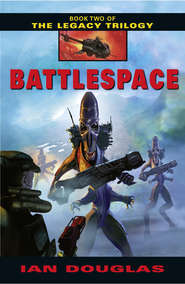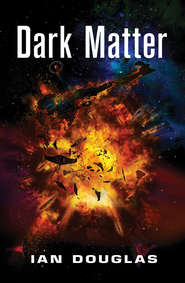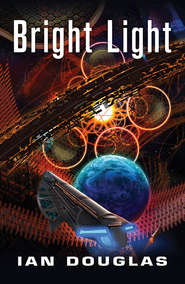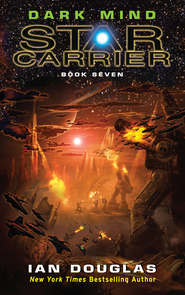По всем вопросам обращайтесь на: info@litportal.ru
(©) 2003-2024.
✖
The Star Carrier Series Books 1-3: Earth Strike, Centre of Gravity, Singularity
Настройки чтения
Размер шрифта
Высота строк
Поля
Unsupported, the carrier wouldn’t have a chance in ten of survival.
And so Koenig had deliberately violated his orders. The phrase “if the tactical situation warranted” was his loophole, his way out. So far as Koenig was concerned, the tactical situation did not warrant either splitting his fleet or trying to run the show from over six light hours away. The phrase was, in fact, a cover-your-ass clause for the politicians; if America and her battlefleet were destroyed or suffered serious damage, the admirals and the Directorate senators could shrug and say, “Well, it wasn’t our fault. Koenig disobeyed orders.”
Pretty standard stuff. If the Confederation won and the Marines were successfully evacuated, the breach of orders would be quietly ignored. Otherwise …
Three hundred kilometers ahead, the escort Farragut had changed course, moving across America’s path to help shield the carrier from oncoming missile volleys. Two Turusch missiles struck the escort’s shields, the twin, silent flashes minute but dazzling on the CIC display screens.
But Confederation fire was hammering home among the Turusch ships as well. The Kinkaid continued to slam high-velocity kinetic-kill projectiles into the suspected enemy command-control ship. America was cycling her spinal mount weapon as quickly as possible—firing about once each fifteen seconds—targeting the same Turusch asteroid ship. If they could just keep up the pressure, if they could keep the enemy command ship’s shields up …
“Farragut reports heavy damage,” Hughes reported. “She’s falling out of the fight.”
Koenig turned in his seat to check one of the monitors relaying visuals from a battlespace drone out ahead of the carrier. Farragut was a missile escort, small and fast with a bundle of twenty-four mamba launch tubes tunneling through the center of her forward shield cap, massing 2200 tons and carrying a crew of 190 men and 15 officers. The ugly little missile boats were designed to dash in close, loose a swarm of high-yield smart missiles in the merge with the enemy formation, and accelerate clear under high-G boost. On the display, the Farragut was barely making way, her drive fields dead; he could actually see her on the screen, which meant her gravitic shields were down or intermittent only, and a portion of her aft drive structure was a tangled mass of wreckage, glowing white-hot and trailing a stream of half-molten debris like streaming sparks in the night. Another missile struck the craft, the flash lighting up the display, a dazzling, single pulse of light, and as the glare faded, the Farragut reappeared, her drive section gone, the forward stem and shield cap tumbling end-over-end. Radiation scanners aboard the drone were pegging the readouts in CIC off the scale.
There was no sign of escape pods evacuating the hulk. Two hundred five men and women …
The missile boat’s skipper, Maria Hernandez, had been America’s Operations officer until she’d been promoted to captain and given command of the Farragut.
She’d also been a friend.
“Controller,” Koenig said.
“Yes, sir.” The controller was Commander Vincent Reigh, and he was responsible for directing all fighters and other secondary spacecraft operating in America’s battlespace—the voice who directed the fighters to their targets and who passed new orders to the fighter squadrons as the combat situation changed.
“Have all fighters concentrate on target …” He paused to read the code group off the tac display. “Target Charlie-Papa One.” Charlie because it was the probable enemy command ship, Papa for a planetoid converted into a warship, and One because it was the most massive vessel so far spotted within the enemy fleet.
“All fighters to target Charlie-Papa One, aye, aye, Admiral.”
Right now, most of America’s fighters had merged with the enemy fleet and passed through to the other side. There, they would decelerate, reform, and begin accelerating back through the enemy fleet, joining the five fighters coming out from Eta Boötis’s night side.
Silent detonations continued to pulse and strobe throughout the Turusch fleet, but more and more were concentrating on the enemy command vessel. So damned little was known about Turisch combat psychology, even after the disasters at Arcturus Station and Everdawn. If the carrier group could decapitate the enemy by taking out that Charlie-Papa … would that be enough to send the rest of them running?
White light filled heaven outside America’s shields, and the combat display broke up momentarily in static. “What’s our Trapper?”
“Transmission percentage at sixty-one percent, Admiral.”
As the Confederation fleet attempted to interfere with the enemy command vessel’s ability to transmit orders to other Turusch vessels, the Turusch were attempting to do the same, blasting away at America’s shields to force them to stay up, blocking radio and lasercom signals to the other battlegroup ships. Transmission percentage—“Trapper”—was a measure of the clarity of ship-to-ship communications during combat. The harder the enemy hammered at America’s shields, the harder it would be to transmit orders to the rest of the battlegroup, or receive tactical updates and requests. Sixty-one percent was actually pretty good. It meant America’s shields were open and signals were getting through almost two thirds of the time.
But that was changing quickly as the two fleets moved toward the merge. …
SAR Red-Delta
90 km south of Red-Mike HQ
Eta Boötis IV
0015 hours, TFT
“There! To the left!”
“God be praised! I see him.”
The UT-84 battlefield hopper, a stubby, blunt-nosed tri-wing, canted sharply to port and descended. Its outer hull nanoflage shifted to reflect the murky night, the utility craft’s gravs howling as they bit through the thick atmosphere. Powerful spotlights stabbed down through the gloom, centering on a lone figure struggling atop a low rock outcropping. The guy appeared to be nearly smothered beneath a shifting, oozing mass of darkness.
“Shit! What are those things?”
“We call them shadow swarmers. His e-suit should protect him, God willing, if they’ve not been swarming him for too long. …”
Lieutenant Charles Ostend gave his passenger a sidelong glance, then shook his head. God willing? Muhammad Baqr was okay as collies went, but he shared the religious passion of all of the other Mufrids. The God-shouting fundy colonists on this miserable rock were utterly beyond his comprehension with their conviction that everything, including their very survival, depended solely upon God’s will.
Hell, why anyone would voluntarily choose to live in such a place in the first place was a question Ostend and his buddies in the 4
SAR/Recon Group had discussed endlessly in after-hours bull sessions ever since the Marines had landed and set up the perimeter. That had been … what? Five weeks ago? He checked his internal calendar. Yeah. Thirty-seven days. Earth days, not the crazy-short daylight cycles they had here.
Shadow swarmers? He’d not heard the term before, but it made as much sense as anything else on Ate a Boot. They’d homed in on a military distress transmission—a rescue beacon in a downed flier’s e-suit. They’d found him … but the guy was almost smothered by a mass of dark gray, leaf-shaped things. Ostend had the impression of millions of cockroaches, each bigger than a man’s outstretched hand and fingers.
He shuddered as he brought the SAR hopper’s nose high and gentled toward bare rock. He hated roaches, had an almost phobic fear of the things, and he didn’t want to think about what was going through that downed pilot’s mind right now.
The guy was alive, at least. Ostend could see arms and legs weakly thrashing about as he tried to pull, scrape, or kick the verminous creatures off of him.
“Okay,” Ostend said, uncertain. “How do we get to him?”
“We pull him inside,” Baqr told him. “The local life forms cannot tolerate high concentrations of oxygen.”
“Hey, Doc!” he called over the craft’s intercom. “We’ve got him in sight! But there’s a bit of a complication!”
“Doc” was a Navy corpsman, HMC Anthony McMillan, riding on the hopper’s cargo deck aft.
“What complication, Lieutenant?” McMillan replied.
“He’s covered with local crawlies. We need to pull him out of there. Mohammed says the oxygen in our air mix’ll kill them.”
“We’ll get him,” McMillan said. “Just get us there.”
The hopper’s two angled ventral wings folded up and rotated back out of the way as landing skids extended, and the craft gentled down ten meters from the writhing mass of swarmers. The port-side cargo-bay door irised open, and two men in Marine utility e-suits and armor jumped out, jogging toward the downed man, the spiders strapped to their backs flexing and working against the planet’s gravity. As they moved through the spotlight beams ahead of the hopper, exaggerated shadows shifted and flickered through dust-illumined shafts of light.
Ostend and Baqr watched from the hopper’s cockpit, keeping the external lights centered on the writhing figure atop the low rock outcrop. One of the corpsmen began pulling swarmers off the man’s suit, peeling them off by the fistful and flinging them away into the darkness. The other was plugging something into the pilot’s helmet.
“What are those swarmer things doing to him, anyway?” Ostend asked.
“Trying to eat him, of course,” Baqr said with a shrug. “Or, rather, trying to eat his e-suit. They must have become sensitized to the carbon in his e-suit.”
“They eat carbon?”
Baqr gave him a mild look. “So do you and I. The life on Eta Boötis is carbon-based, as is the life on Earth. And carbon-based life requires sources of carbon for growth and metabolism. Most of the mobile life forms here get the carbon from carbonaceous mineral deposits—they are lithovores. The sessile forms get it from the carbon dioxide in the atmosphere—lithoautotrophs.”
“So, just like plants and animals on Earth.”
“Only by very rough analogy. The mobile forms, the swarmers, are more like Earth’s plants, actually, getting what they need from the soil. Very active plants. They can be so here, with the abundance of energy available on this world.”











